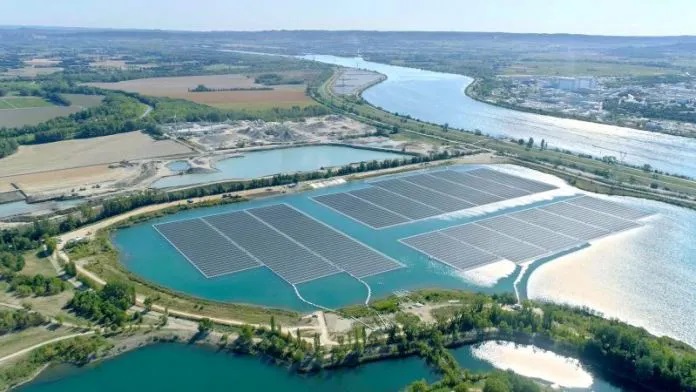The most powerful floating solar PV plant in Europe was inaugurated in southern France on Friday (18 October), marking another milestone in the development of solar energy.
The Rhône valley in southern France is best known for its fine wines and gorgeous food. Now, it can also add solar power to its list of attractions.
The O’MEGA1 project is a 17 megawatt (MW) solar plant situated in Piolenc, a commune in the Vaucluse department, near Orange and Avignon.
The project is unique in several ways. To start with, it is the largest in Europe based on floating solar technology. According to its promoters, the floating structure helps reduce conflicts over land use because it can be installed on drinking water reservoirs, industrial pools, flood plains or quarry lakes.
Citizen energy
But the solar plant also innovates in its local community dimension, with citizens invited to take a stake in the project. Marking a first in France, the plant’s capital was opened to physical people who have a home in the Vaucluse or in neighbouring departments.
“Today, as well as inaugurating Europe’s largest floating solar plant, we are showing that fighting climate change requires a collective effort,” said Eric Scotto, chairman and co-founder of Akuo Energy, the solar PV developer.
“The aim of this approach is to encourage citizens to become involved in the financing of the energy transition using the region’s stakeholders,” Akuo said in a statement.
‘Green electricity of controlled origin’ label
The project’s innovative aspect doesn’t stop there. Akuo Energy also teamed up with an independent electricity supplier, Plüm Energie, to develop a “green electricity of controlled origin” label, which will be the first of its kind in France.
“This offer guarantees its future clients 100% renewable energy produced exclusively in France, hence creating value in this country,” Akuo said.
Works on the O’MEGA1 project started in 2014, on the site of an old quarry that was converted into a lake. The plant is now officially inaugurated today, in presence of French ecology minister Elisabeth Borne and her secretary of state, Brune Poirson.
According to its promoters, the plant’s annual output will be sufficient to power 4,733 homes, avoiding the emission of 1,096 tons of CO2 into the atmosphere.
‘Immense’ potential
This is tiny compared to the 1,500 MW of an offshore wind farm such as Hywind in Scotland, which can power up to 1 million homes. But the industry says a myriad of similar projects could see the light in the coming years.
“The market potential for floating PV is immense, with a recent study from the World Bank showing that if only 1% of artificial reservoir surfaces were used, the global capacity for floating solar would amount to 400 GW,” said Walburga Hemetsberger, CEO of SolarPower Europe, a trade group.
“Floating solar plants are an innovative and proven market sector on a rapid upward trajectory, and a perfect solution for countries with restricted or under–utilised land areas,” Hemetsberger told EURACTIV.
In France, the potential of floating solar is estimated at 20 gigawatts (GW), spread over a potential 1,300 sites – mainly old industrial areas, hydropower dams and water reservoirs.
“There is sufficient potential for us to develop the technology and replicate it on an industrial scale,” said Alexandra Sombsthay, director at Akuo in charge of external relations.
And several projects are already underway in Europe. In Belgium, the Flemish government announced six floating PV projects totaling 11.1 MW earlier in January. In Portugal, there are plans for a hybrid hydro-solar project which involves installing floating solar panels on a reservoir to supplement an existing hydro plant.
According to Hemetsberger, “There is a terawatt-scale opportunity for floating solar, and we are confident that in the coming years many projects will follow Akuo’s lead.”
The original: https://www.euractiv.com.


